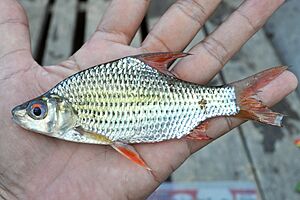Beardless barb facts for kids
Quick facts for kids Beardless barb |
|
|---|---|
 |
|
| Cyclocheilichthys apogon from Sambas, West Kalimantan, Indonesia |
|
| Conservation status | |
| Scientific classification | |
| Synonyms | |
|
Barbus apogon Valenciennes, 1842 |
The Beardless Barb (scientific name: Cyclocheilichthys apogon) is a type of freshwater fish. It belongs to the Cyprinidae family, which includes many well-known fish like carp and minnows. This fish is found all over Southeast Asia. It can grow up to 25 centimeters long, which is about the length of a standard ruler.
What Does It Look Like?
The Beardless Barb gets its name because it doesn't have 'barbels.' Barbels are whisker-like feelers that some fish have around their mouths. This fish has a special look with a black spot near its tail. It also has rows of small black spots along its scales. These spots help it blend in with its surroundings. As mentioned, it can grow up to 25 centimeters long. Studies in Borneo showed that young Beardless Barbs can reach about 8.1 centimeters by the time they are two years old.
Where Does It Live?
The Beardless Barb lives in many different freshwater places. You can find it in rivers, swamps, and marshlands. It also lives in lakes and reservoirs. During the rainy season, when water levels rise, these fish are known to migrate. They move into flooded areas to find new feeding grounds and places to lay their eggs.
Where Can You Find It?
This fish is widespread across Southeast Asia. It lives in countries like Myanmar, Thailand, Cambodia, Laos, and Vietnam. It's also found in Malaysia, Singapore, and Indonesia. You can spot them in major river systems like the Mekong and Chao Phraya basins. On islands, they are common in Sumatra and Borneo.
How Is It Used?
The Beardless Barb is important to local communities. People often catch it for food, as it is a common fish in local fisheries. It is also sometimes kept as an ornamental fish. This means it can be found in the pet trade for aquariums.


